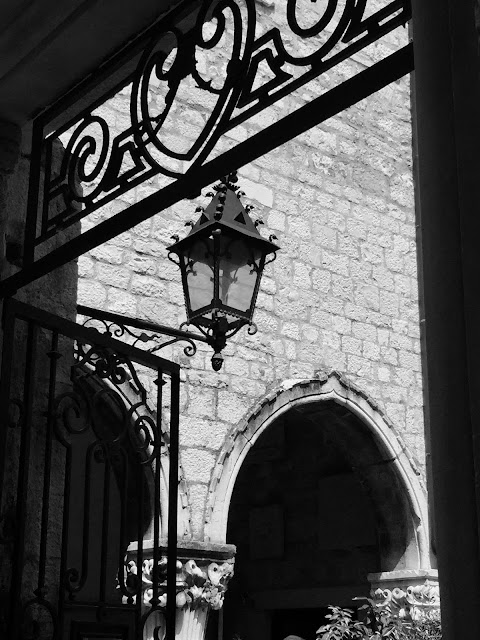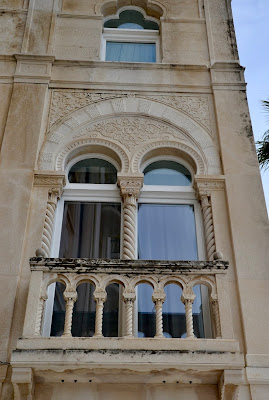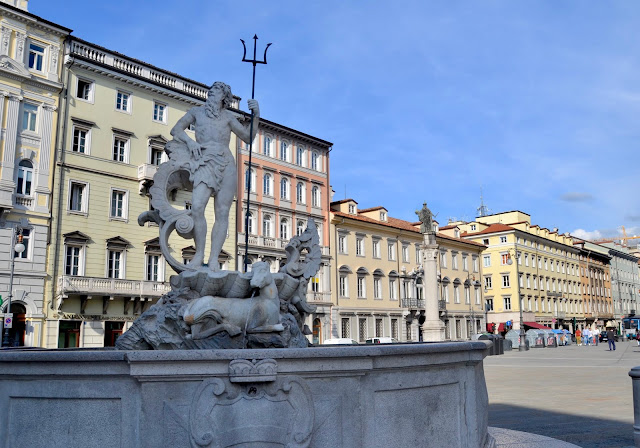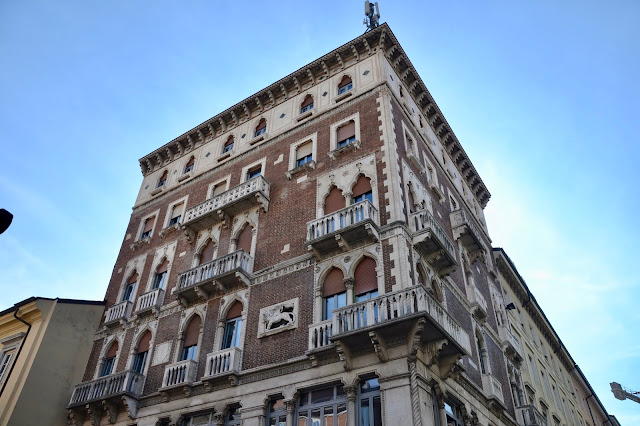Split, Croatia May 15, 2018
Wow! Who Knew!
After our ship docked, we walked from the very busy harbour, full of ferries, yachts and fishing boats to the beautiful waterfront promenade. There we heard about Diocletian's Roman Palace - built by the Roman, Diocletian in 306 AD. When the Romans abandoned the Palace in the 7th century, the locals moved into the safety of this walled palace and have been here ever since. The apartments within the palace have been handed down generation after generation.
 |
| Riva - the Waterfront Promenade |
 |
| Diagram of the original Roman palace built by Diocletian in 305 AD |
 |
| Our guide helping us get our bearings in the maze of the palace and the adjoining medieval town streets |
The outside of the palace as seen today - and still being lived in 1700 years later.
Facing the harbour, Diocletian’s Palace is one of the most imposing Roman ruins in existence and where you’ll spend most of your time while in Split. Don’t expect a palace though, nor a museum – this is the city's living heart, its labyrinthine streets packed with people, bars, shops and restaurants. Built as a military fortress, imperial residence and fortified town, the palace measures 215m from north to south and 180m east to west, altogether covering 38,700 sq metres.
Although the original structure has been added to continuously over the millennia, the alterations have only served to increase the allure of this fascinating site. The palace was built in the 4th century from lustrous white stone transported from the island of Brač, and construction lasted 10 years. Diocletian spared no expense, importing marble from Italy and Greece, and columns and sphinxes from Egypt.
Each wall has a gate at its centre, named after a metal: the Golden Gate(north), Brass Gate(south), Silver Gate(east) and Iron Gat(west). Between the eastern and western gates there’s a straight road (Krešimirova; also known as Decumanus), which separates the imperial residence on the southern side, with its state rooms and temples, from the northern side, once used by soldiers and servants.
There are 220 buildings within the palace boundaries, home to about 3000 people. The narrow streets hide passageways and courtyards, some deserted and eerie, others thumping with music from bars and cafes, while the local residents hang out their washing overhead, kids play football amid the ancient walls, and grannies sit in their windows watching the action below. ~ Lonely Planet
 |
| Still livable apartments after 1700 years. |
We entered the palace from the Riva at the Brass Gate (3 on the map) to the substructure (cellars) - one of the best preserved ancient complexes of their kind in the world. It was pretty cool.
We then walked through to the Peristyle (main square with the Cathedral of St. Domnius)
 |
| In front of the Cathedral is a granite Sphinx brought from Egypt in the 4th century |
 |
| Modern hotel reno in the old Roman ruins. |
In the Vestibule, we hear an a capella folk group. The setting and music were both incredible
 |
| Ancient Graffiti |
The City Museum
 |
| The Venetians conquered Split in the 1400's. The Venetian style of architecture can be seen throughout the palace. |
 |
| Diocletian and his Wife |
 |
| Deliveries made by cart |
 |
| Temple of Jupiter |
 |
| A cool spot for a patio |
 |
| The old roman buildings have been renovated many times over 1500 years, but the original structure is essentially still there. |
The Golden Gate
 |
| Bishop Gregory of Ninn, just outside the Golden Gate - It's good luck to wish on his toe. |
The Iron Gate
In the Pjaca - The Peoples Square just outside the Iron Gates
This was a great place shop, get lost in the maze of little streets and get some lunch
 |
| An exit onto the waterfront with a storefront renovated in the Venetian style. According to our guide, no changes can now be made to the exteriors of any buildings within the palace (as it's a UNESCO heritage site) , but you can renovate the interiors as you like. |
 |
| The Neo-Renaissance Prokurativ Square on the waterfront |
 |
| Back on ship, we were in for some rocky weather |
Time for choir practice with Bob Porter, artistic director of the London Brandenburg Festival. A big commitment with practices for one hour every day ... but lots of fun. I looked forward to going every day with this talented group of cruisers.
TRIESTE, Italy
Trieste became the fourth largest city of the Austro-Hungarian Empire (after Vienna, Budapest, and Prague and was under the Hapsburg Monarchy from 1382 until 1918). Trieste was an important spot in the struggle between the Eastern and Western blocs after WWII, because it its location near the the Slovenian border. Trieste is also know as the coffee capital of the world.
 |
| A famous cafe - Cafe Secchi |
 |
| Glad we stopped - a beautiful cappuccino with a choc mousse on the side. |
Trieste has had so many architectural and cultural influences over the years.....
......It looks like Prague
.......It looks like Vienna
.....Looks like Athens
...looks like Venice
also of course it has Roman Ruins.
While touring the roman site, a school group was there and the fire department showed up with sirens going. Apparently a little boy locked himself in a washroom . Anyway, thanks to the firemen, they got him out safe and sound.
 |
| This 3 pointed Halberd, that apparently dropped from the sky ( & displayed in the church as a holy icon) has become the symbol of Trieste and you will see it on their city flag and on many signs. |
The long awaited choir concert! Any cruiser who liked to sing was invited to join the Brandenburg Choir by director Bob Porter. We sang a variety of pieces from Vivaldi, to Mozart, to spirituals, to Kirby Shaw - good thing most were good sight readers. Great fun! ...and we sounded pretty good too.


















































































No comments:
Post a Comment